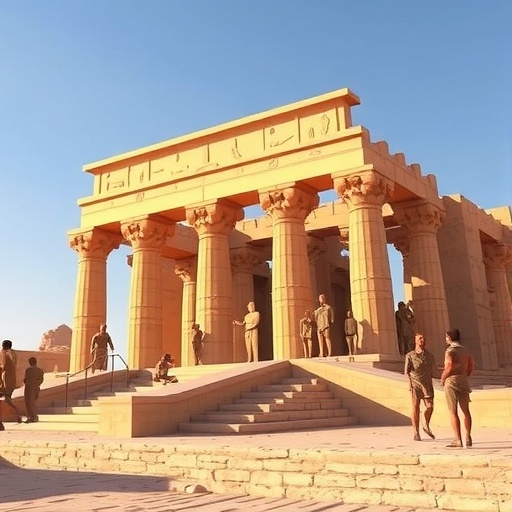A groundbreaking geoarchaeological investigation has illuminated the origins and developmental history of Karnak Temple, one of the most expansive and architecturally complex ancient religious sites in Egypt. Situated in Luxor and renowned as a UNESCO World Heritage site, Karnak has fascinated scholars for centuries. Now, through a meticulous scientific study integrating core sediment analysis and ceramic typology, researchers have provided compelling evidence about the temple’s earliest occupation, its evolving interaction with the Nile’s dynamic river channels, and its deep-rooted connections to Ancient Egyptian cosmology.
The international research team, led by experts from Uppsala University and the University of Southampton, undertook the most detailed geoarchaeological survey ever conducted at Karnak. They extracted and examined 61 sediment cores spanning the temple complex and its surrounding floodplains, accompanied by an exhaustive evaluation of tens of thousands of ceramic fragments uncovered from various interface layers. This multi-proxy approach enabled them to reconstruct a high-resolution paleoenvironmental timeline that traces back to the pre-Old Kingdom era, revealing pivotal insights into the site’s landscape evolution and human occupation chronology.
Prior to around 2520 BCE, the study infers that the site where Karnak now stands was unsuitable for continuous settlement and construction due to recurrent flooding events caused by rapidly flowing Nile branches. These hydrological conditions precluded the establishment of permanent structures by early inhabitants. However, sediment stratigraphy coupled with ceramic dating constrains the onset of steady cultural activity on this site to the Old Kingdom period, roughly between 2591 and 2152 BCE, with actual ceramic evidence dating between circa 2305 and 1980 BCE. This indicates a relatively late foundation compared to some prior hypotheses that suggested earlier settlements.
The temple complex’s unique platform—a naturally formed island of elevated terrain—originated when incised fluvial channels carved their way through the landscape, isolating this high ground from the surrounding floodplains. These channels, identified on both the western and eastern flanks of the site, played a crucial role in shaping how Karnak’s monumental structures could be conceived and built. Remarkably, the eastern channel, previously only hypothesized, has now been demonstrated to have been a prominent and potentially larger watercourse than its western counterpart, overturning decades of archaeological focus that favored the western channel’s geomorphology.
This geomorphic setting had significant architectural and religious implications. As river channels shifted and gradually silted up through centuries, new land surfaces became available for the incremental expansion of the temple complex. The research uncovers evidence that Ancient Egyptians actively managed these fluvial systems, notably by introducing desert sands into the channels. Such anthropogenic modifications likely served practical purposes—reclaiming land for construction and ritual activities—as well as demonstrating the profound interconnectedness between their spiritual beliefs and environmental management.
The study further posits that the founders of Karnak might have deliberately chosen this distinctive island for its symbolic resonance with Ancient Egyptian creation myths. According to Old Kingdom texts, the primordial god emerged from a cosmic lake as a mound of high ground—the ur-‘primeval mound’ representing the origination of order from chaos. Karnak’s geographical characteristics uniquely mimic this mythological tableau: an island of dry land surrounded by water, evocative of the sacred ‘primeval mound’ rising from the ‘Waters of Chaos’. This potential alignment suggests religious and cosmological motivations fundamentally intertwined with the temple’s siting and conceptual genesis.
During the Middle Kingdom era, these creation motifs were crystallized in religious literature describing the abatement of the Nile’s annual inundation, which physically manifested the emergence of the sacred mound from receding floodwaters. This natural hydrological phenomenon might have reinforced the symbolic significance of Karnak’s geographic arrangement, further integrating landscape, ritual, and theology in Ancient Egyptian worldview. It manifests a striking example of how physical geography and belief systems interplayed to inspire monumental architecture.
Lead author Dr. Ben Pennington highlights how this research transforms the understanding of Karnak’s complex from a static assembly of religious buildings into a living, evolving institution deeply informed by its environmental context and spiritual narratives. The findings expand methodological horizons in geoarchaeology by combining sedimentological data with archaeological materials, offering a template for investigating other archaeological sites situated within dynamic fluvial landscapes.
The project also underscores that earlier assumptions about Karnak’s development need revision, with previous archaeological discourse emphasizing solely the western Nile channel now supplemented by recognition of the eastern channel’s critical role. This dual-channel system redefines interpretations of the temple’s expansion and the interaction between human activity and natural processes in Ancient Egypt’s religious capital of Thebes.
Looking forward, the research team is expanding their focus to investigate the broader Luxor floodplain, employing their integrative geoarchaeological approach to elucidate the landscapes and waterscapes that shaped religious and urban development within the Theban region. Their ongoing efforts promise to further unravel the complex interrelations between environment, culture, and mythology that characterized Ancient Egyptian civilization.
Published in the premier journal Antiquity, this study represents a milestone in archaeological science. It provides a robust temporal framework and substantiates the conceptual origins of the temple of Amun-Ra within its unique geomorphological setting. This advances scholarship on not only Karnak but also wider discussions on the role of natural landscapes in the creation of sacred spaces in antiquity.
In sum, this comprehensive study reframes Karnak Temple as both a physical and symbolic locus where dynamic riverine landscapes, human agency, and ancient religious thought converged over millennia. It solidifies the temple’s foundational narrative while opening promising avenues for future interdisciplinary investigation into Egypt’s archaeological and geological past.
Subject of Research: Geoarchaeological origins and landscape evolution of Karnak Temple, Luxor, Egypt
Article Title: Conceptual origins and geomorphic evolution of the temple of Amun-Ra at Karnak (Luxor, Egypt)
News Publication Date: 6 October 2025
Web References: http://dx.doi.org/10.15184/aqy.2025.10185
Image Credits: Dr Ben Pennington
Keywords: Egyptology, Classical archaeology, Archaeology, Geography, Hydrology




